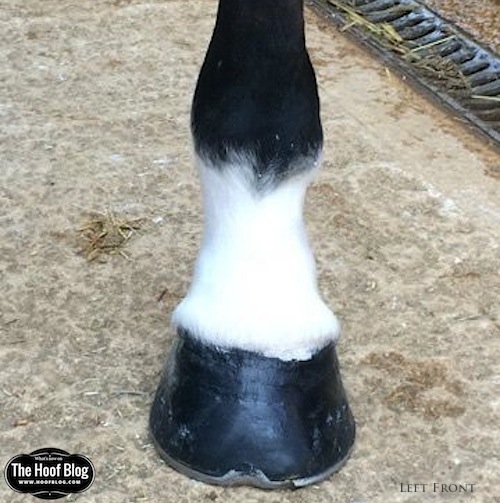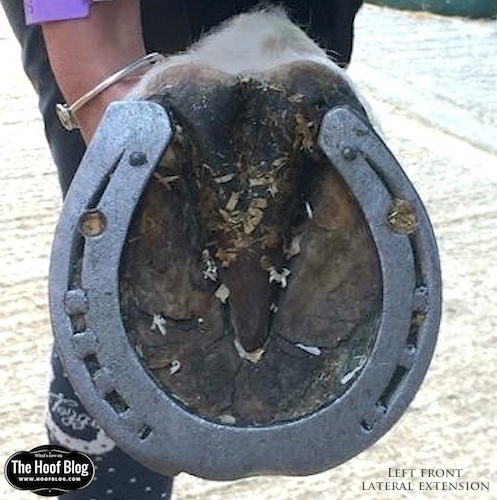This is Part 2 of a two-part article. Before reading the specifics of how this horse is shod, please read Part 1, posted on May 8th.
On Sunday, the Mitsubishi Motors Badminton Horse Trials in England announced the winner of the Worshipful Company of Farriers' prestigious Farriers Prize. The award is made annually after inspection of all horses that survive the first two phases of the three-phase event, as they proceed to the third and final phase.
 Judging the hooves was the task of Jim Blurton, AWCF, of Wales, who will be Farrier Team Leader at the Rio 2016 Olympics this summer. With Jim was Brazil's Luiz Gustavo Tenório, DVM, Farrier Coordinator for the Games, who was visiting the United Kingdom.
Judging the hooves was the task of Jim Blurton, AWCF, of Wales, who will be Farrier Team Leader at the Rio 2016 Olympics this summer. With Jim was Brazil's Luiz Gustavo Tenório, DVM, Farrier Coordinator for the Games, who was visiting the United Kingdom.The winning horse, a 13-year-old British Sport Horse named Allercombe Ellie, ultimately finished eighth and also received the breeding award for the event. She was ridden by England's Izzy Taylor, and shod by her boyfriend, Charlie Sands, DipWCF. The shoes were made by Charlie's fourth-year apprentice, Ryan McDonald of Wales, who competes on the Welsh Farrier Apprentice Team.
Please see Part 1 of this article for more details about the event, the prize, the rider, the owners, and the horse.
Charlie Sands arrived home late last night and took the following photos of the mare's shoes and hooves this morning.
 |
Apprentice Ryan McDonald
made the shoes for the
winning horse.
|
"Best shod" classes at a three-day event are not beauty contests. Most of the horses have battle-scarred feet. They often have conformation faults. The award is sometimes vague in what counts toward the win. In the past, Blurton has commented on the psychology of seeing the horse through the farrier's eyes, and unraveling the problem-solving process of dealing with a conformation flaw or an old injury.
Think of it this way: there are many things a skilled farrier can do to a horse's foot. This event is a chance to not only show off skill, but to illustrate to the horse world what a farrier can do for a horse's foot. That is why the Hoof Blog likes to write about these prizes, with the help of the winning farrier and the judge, when possible.
About the shoeing
 |
Charlie Sands, DipWCF (photo by
Uptown Eventing, used with permission) |
What makes this story especially interesting is that, as you might expect, the mare is shod with handmade shoes. But Charlie Sands didn't make them. Instead, he turned the job over to his fourth year apprentice, Ryan MacDonald.
You might have done the same. Charlie says that Ryan is very keen on shoemaking--and very good at it. He's even on the Welsh Apprentice Farrier Team.
Once Ryan crafted the shoe, it was up to Charlie to get under the horse and make it work.
To level up the mare, Charlie has found that what works best is a set-down toe 3/4 fullered lateral extension shoe made from inch x 5/16" stock. Charlie said the outside branch is about an inch wide, tapering from the outside toe to the heel. He used regular E-head (European style) nails and shod the hind feet normally, which he described as "hunter hind concave, with a little width on the outside."
"I get a bit of flack about this horse," Charlie admitted. He's consulted with other farriers on how to help the mare, but the consensus has been that what he's doing works. Obviously Jim Blurton, himself a former world champion farrier and Olympic staff farrier for both the 2012 London and upcoming 2016 Rio Olympics, agreed with the approach for this horse.
Left hind foot of the winning horse is shod with the traditional British hunter style shoe, which is made from a section of "concave" steel that slopes from the ground surface to the coverage area. This shoe and its features look strange to Americans so here's an explanation. The shoe provides a wider platform for the hoof bearing surface than the narrower section that strikes the ground. The full crease of the shoe carries the traditional seven nails and is filled with dirt and bedding. The shoe is punched at the toe quarter for side clips, drilled at the heel quarter for removable studs, and also has two interesting hard-facing pins, or road studs, that are almost flush with the inside web of the shoe near the heels. The inside heel is tapered according to British style.
The right hind is shod similarly to the left.
The front feet wear flat shoes made from inch x 5/6" stock. The shoes are top-clipped and have the permanent road studs ("pins") and stud holes seen on the hinds.
Right front foot shape and toe clip.
Left front foot shape and toe clip.
Left front shoe is an asymmetric flat shoe that is technically a lateral exension shoe, as well. The inside branch is 3/4" wide; the outside branch is one inch wide and set down on the outside toe.
What's a lateral extension shoe?
 |
The simplest way to create a lateral
extension is to displace the steel
with the fuller. (Loic Entwistle photo,
used with permission)
|
Some lateral extension alterations are hardly visible (at first) to the naked eye.
Many farriers use lateral extensions on the hind feet of dressage horses when the hocks need some help to achieve the gaits and movements needed in soft footing.
There doesn't seem to be a formula for how much width is the right amount or for how long to continue shoeing a horse with extra lateral width. On some hind feet, the extension can look like a wing. It's possible that the extension will change in width in subsequent shoeings.
Riders often say they can sense a change in a horse after the addition of a lateral extension shoe or shoes. Case selection for altering shoe width and where width is added is critical; adding a lateral extension where it is not needed (or wanted, by the horse) may be counterproductive to performance and soundness.
In the case of Allercombe Ellie at the Badminton Horse Trials last week, it was the right thing to do to, and for, the mare, in the eyes of the judge.
(Learn more about lateral extension shoes by downloading an article about Haydn Price's use of them on dressage horses from the Hoofcare and Lameness archives.)
Many thanks to Charlie Sands, Ryan McDonald, Jim Blurton and everyone who was enthusiastic about the Farriers Prize at Badminton this year.
The stables at Badminton House, and resident farrier Bernie Tidmarsh.
--------------------------------------------------------------------------------------------------
Click here to download the order form for your copy of Professor Pollitt's book and access to his private video library of animated 3D videos keyed to book chapters. Or, simply call 978 281 3222 or email books@hoofcare.com
© Fran Jurga and Hoofcare Publishing; Fran Jurga's Hoof Blog is the news service for Hoofcare and Lameness Publishing. Please, no use without permission. You only need to ask. This blog may be read online at the blog page, checked via RSS feed, or received via a headlines-link email (requires signup in box at top right of blog page). Questions or problems with this blog? Send email to blog@hoofcare.com.
Follow Hoofcare + Lameness on Twitter: @HoofBlog
Read this blog's headlines on the Hoofcare + Lameness Facebook Page
Disclosure of Material Connection: The Hoof Blog (Hoofcare Publishing) has not received any direct compensation for writing this post. Hoofcare Publishing has no material connection to the brands, products, or services mentioned, other than products and services of Hoofcare Publishing. I am disclosing this in accordance with the Federal Trade Commission’s 16 CFR, Part 255: Guides Concerning the Use of Endorsements and Testimonials in Advertising.











